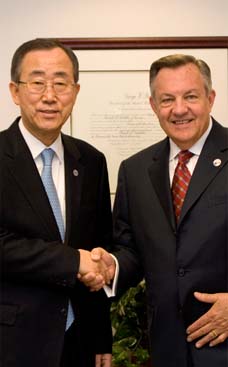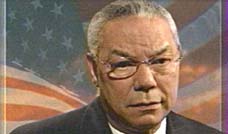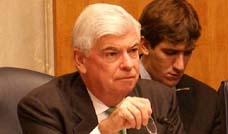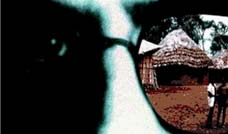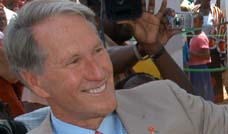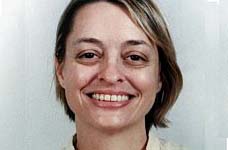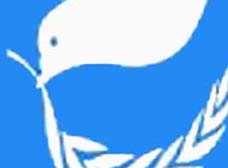
Mr. Puryear’s work is humorous but not ironic. It has a complex worldview devoid of trendy critique. It offers more integrity than innovation and proves repeatedly that accessible doesn’t rule out subtle. Like Elizabeth Murray, who was also the subject of a recent MoMA retrospective, Mr. Puryear has pursued what might be called an old-fashioned approach to the new. But really, both have done nothing more, or less, than ground formalism in the rich world of their own experience and identity. And that is new enough. Award winning sculptor Martin Puryear served as a Peace Corps volunteer in Sierra Leone in the 1960's where he met and studied with traditional craftsmen, who taught him to work wood with hand tools.
Martin Puryear’s treatments of wood verge on the encyclopedic and give the material an almost animal diversity, creating a kind of rainbow coalition of contrasting skin tones and textures, bone structures, muscle densities and personalities
Humanity’s Ascent, in Three Dimensions
By ROBERTA SMITH
Published: November 2, 2007
On Sunday, when the Museum of Modern Art’s 30-year retrospective of the sculptor Martin Puryear opens, the New York art world will find itself in what may be an unprecedented situation. For the first time in recent memory — maybe ever — two of the city’s most prominent museums will be presenting large, well-done exhibitions of living African-American artists. The Whitney Museum’s 15-year survey of Kara Walker’s work has been searing hearts, minds and eyes since it opened early last month. Now it is Mr. Puryear’s turn to weave his finely nuanced yet insistent spell.
Perhaps in the future welcome and overdue coincidences like this will no longer merit mention. In the meantime this one has the added bonus of representing radically different ways of being an artist, black or otherwise. Ms. Walker comes out of Conceptual and appropriation art and makes the bitter legacy of race relations in this country the engine of her cut-paper installations, animated films and language pieces.
Mr. Puryear, who was born in 1941 and grew up in Washington, D.C., is a former painter who emerged from the Minimalist and Postminimalist vortex making hand-worked, mostly wood sculptures. These soothe more than seethe, balancing between the geometric and the organic with Zen aplomb.
Mr. Puryear is a formalist in a time when that is something of a dirty word, although his formalism, like most of the 1970s variety, is messed with, irreverent and personal. His formalism taps into a legacy even larger than race: the history of objects, both utilitarian and not, and their making. From this all else follows, namely human history, race included, along with issues of craft, ritual, approaches to nature and all kinds of ethnic traditions and identities.
These references seep out of his highly allusive, often poetic forms in waves, evoking the earlier Modernism of Brancusi, Arp, Noguchi and Duchamp, but also carpentry, basket weaving, African sculpture and the building of shelter and ships. His work slows you down and makes you consider its every detail as physical fact, artistic choice and purveyor of meaning.
The MoMA show, which has been organized by John Elderfield, the museum’s chief curator of painting and sculpture, is quite beautiful and conveys Mr. Puryear’s achievement persuasively. With 40 works on the sixth floor and 5 more on the second-floor atrium level, it displays a lack of repetition unusual in these product-oriented times. Of the five in the atrium, two are attenuated sculptures that reach upward several stories, making new use of that tall, awkward space. “Ladder for Booker T. Washington” from 1996 is a wobbly ladder whose drastic foreshortening makes it seem to stretch to infinity.
It suggests that the climb to success is deceptively long — and perhaps longer for blacks than whites. But its limitless vista also has a comedic joy worthy of Miró.
Mr. Puryear once said of Minimalism, “I looked at it, I tasted it, and I spat it out.” But he has taken a lot from it, and used it better and more variously than many of his contemporaries.
While rejecting Minimalism’s ideal of being completely nonreferential, he said yes to its wholeness, stasis and hollowness, to sculpture as an optical, imagistic presence that nonetheless can’t be known completely without walking around it. Above all he applied the Minimalist embrace of new materials in a retroactive manner: using wood in so many different ways that it feels like a new material, both physically and poetically.
Mr. Puryear’s treatments of wood verge on the encyclopedic and give the material an almost animal diversity, creating a kind of rainbow coalition of contrasting skin tones and textures, bone structures, muscle densities and personalities. Surfaces are light or dark, matte or gleaming, smooth or bristling, richly stained or au naturel. Woods are thick, thin and very thin; opaque or transparent; solid or skeletal.
Each piece is to some extent a new start, with its own integrity and references. Topped by a layer of dried mud, the squat bulletlike block of weathered wood that is “For Beckwourth” (1980) conjures up an Indian lodge, a Baule sculpture coated with dried sacrificial material, an early Greek tomb and a nondenominational church dome. (These associations can arise before a label informs us that James Beckwourth, the son of a black mother and a white father, was born into slavery and was eventually made a chief of the Crow Indian nation.)
The elegant 1975-78 wall piece “Some Tales” is a series of lines so spare they might almost be drawn, but are in fact long, thin pieces of wood, abstract yet glowing, with intimations of human use, and somehow sinister too. They bring to mind drumsticks, an oxen yoke, saws, bullwhips, tree branches. One long loop is both a giant hairpin and a rope ready for coiling into who knows what. “Bask” (1976) is a low-lying floor piece in black-stained pine, tapered at both ends, but with a gently swelling center. It suggests a sleeping seal, but also a rolling wave of oil that might kill a seal.
Skip to next paragraph
Multimedia
Martin PuryearSlide Show
Martin Puryear
A mysterious seductive blackness, one of Mr. Puryear’s touchstones, dominates in a large rounded monolith from 1978 whose polished, headlike form is tellingly, even ominously titled “Self” — the dark inescapable thing within us all. But this looming form also tilts oddly, a little like the Rock of Gibraltar or a whale’s breaching snout..
The monolith of “Self” is also a Puryear staple. Later on it is streamlined and open like a rib cage in the lustrous “Bower,” and a kind of crazy scribble in “Thicket” — or as close to a scribble as raw two-by-fours can get. In “Old Mole” it culminates in a beak and its densely crisscrossing lath suggests a creature both blind and bandaged. In “Confessional” the monolith expands into a habitable hut made of a semi-transparent patchwork of wire lightly clotted with tar. One side is truncated by a large plane of wood that might be a door or even a face, at which point the hut mutates into a cowled head, that of a priest or perhaps of Death.
The face of “Confessional” becomes explicit in “C.F.A.O.” (completed this year), whose initials stand for Compagnie Française de l’Afrique Occidentale, the French trading company that sailed between Marseille and West Africa beginning in the 19th century. Its most striking form is an enlarged negative impression of a white Fang tribal mask that is embedded in an impenetrable scaffolding of wood dowels. This in turn rests on a worn-out wheelbarrow: European and African forms enmeshed in an intractable post-colonial chaos.
Mr. Puryear’s work is humorous but not ironic. It has a complex worldview devoid of trendy critique. It offers more integrity than innovation and proves repeatedly that accessible doesn’t rule out subtle. Like Elizabeth Murray, who was also the subject of a recent MoMA retrospective, Mr. Puryear has pursued what might be called an old-fashioned approach to the new. But really, both have done nothing more, or less, than ground formalism in the rich world of their own experience and identity. And that is new enough.






